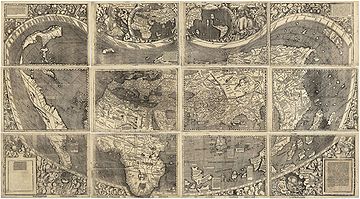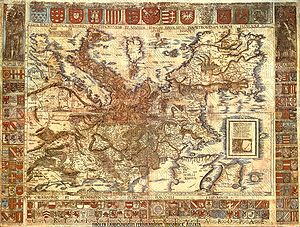- Martin Waldseemüller
-
The title of this article contains the character ü. Where it is unavailable or not desired, the name may be represented as Martin Waldseemueller.
Martin Waldseemüller (Latinized Martinus Ilacomylus, Ilacomilus or Hylacomylus, c. 1470, Wolfenweiler – Saint-Dié-des-Vosges 1520, March 16) was a German cartographer. He and Matthias Ringmann are credited with the first recorded usage of the word America, on the 1507 map Universalis Cosmographia in honor of the Florentine explorer Amerigo Vespucci.
Contents
Life
Waldseemüller was born in Wolfenweiler, then his family moved to Freiburg in Breisgau (his mother came from Radolfzell) and he studied at the University of Freiburg. He died March 16, 1520, "ab intestat", then a canon of the collegiate Church of Saint-Dié (located between Nancy, Lorraine and Strasbourg, Alsace in the heart of the Vosges blue mountain range along the Rhine river valley).
On April 25, 1507, as a member of the Gymnasium Vosagense at Saint Diey (German: Sankt Diedolt) in the duchy of Lorraine (today Saint-Dié-des-Vosges, France), he produced a globular world map and a large 12-panel world wall map (Universalis Cosmographia, both bearing the first use of the name "America". The globular and wall maps were accompanied by a book Cosmographiae Introductio, an introduction to cosmography. The book, first printed in the city of Saint-Dié-des-Vosges, includes in its second part, a translation to Latin of the Quattuor Americi Vespuccij navigationes (Four Voyages of Americo Vespucci), which is apparently a letter written by Amerigo Vespucci, although some historians consider it to have been a forgery written by its supposed recipient in Italy. In the chapter nine of the first part of the Cosmographiae Introductio, written by Mat(t)hias Ringmann (died in Sélestat in the year of Our Lord 1511 at the age of 29), it is explained why the name America was proposed for the then New World, or the Fourth Part of the World:
ab Americo Inventore ...quasi Americi terram sive Americam (from Amerigo the discoverer ...as if it were the land of Americus, thus America).
In 1513 Waldseemüller appears to have had second thoughts about the name, probably due to contemporary protests about Vespucci’s role in the discovery and naming of America, or just carefully waiting for the official discovery of the whole northwestern coast of what is now called North America, as separated from East Asia. In his reworking of the Ptolemy atlas, the continent is labelled simply Terra Incognita (unknown land). Despite the revision, 1,000 copies of the world maps had since been distributed, and the original suggestion took hold. While North America was still called Indies in documents for some time, it was eventually called America as well.
The wall map was lost for a long time, but a copy was found in a castle at Wolfegg in southern Germany by Joseph Fischer in 1901. It is still the only copy known to survive, and it was purchased by the Library of Congress in May 2003,[1] after reaching an agreement in 2001.[2] Four copies of the globular map survive in the form of "gores": printed maps that were intended to be cut out and pasted onto a ball. Only one of these lies in the Americas today, residing at the James Ford Bell Library, University of Minnesota.
H.Res. 287 America
In 2007, US Congressman Alcee Hastings introduced a bill (H.Res 287) to celebrate the 500th anniversary of the first use of the name "America" with the support of the Congressional Black Caucus, the Organizing Committee and mayors in fifty states to champion the national strategy "Bring Home The Spirit of History in your town". Riccardo Gaudino, historian for the America500 Birthday Extravaganza Movement (2007–12) led the campaign for Who Named America? National Youth Literacy for the 21st Century. The resolution passed unanimously on July 11, 2007. Youth requested mayors and governors to issue Who Named America? proclamations for celebrating the "500th Birthday of the naming of America" in earth science to energize youth thirst for knowledge. The cartographer Martin Waldseemuller's print of the globe map resulted in many "firsts" in geography. It was first projection of earth to depict a new land mass not of Africa and Asia, and a new western ocean (known now as the Pacific). The Vision of America500 Birthday Extravaganza 2007-12 was inspired to explore humanity's spirit of ingenuity by celebrating a community story to open local windows to worldwide origins. US mayors & governors proclaimed April "World Geography Month" to energize learning of Waldseemuller globe map, said to have been printed on April 25, 1507, and share new insight into the birth of the word "America" as a milestone in the rise of planetary science.
See also
- Naming of America
- Discoverer of the Americas
- Richard Amerike
- History of cartography
- List of Roman Catholic scientist-clerics
References
- ^ The Map That Named America, Library of Congress, September 2003
- ^ "Library of Congress Acquires Only Known Copy of 1507 World Map Compiled by Martin Waldseemüller", Library of Congress, 2001-07-23
- John Hessler: The Naming of America: Martin Waldseemüller's 1507 World Map and the Cosmographiae Introductio, Library of Congress, 2007
- David Brown: 16th-Century Mapmaker's Intriguing Knowledge, in: Washington Post, 2008-11-17, p. A7
- Toby Lester: Putting America on the Map, Smithsonian, Volume 40, Number 9, p. 78, December 2009
External links
- The Cosmographiæ Introductio of Martin Waldseemüller (Facsimile), via Google Books.
- Silverado Middle School 8th Grade Leadership Class Launches Nationwide Who Named America? Knowledge Movement to commemorat the America500th Birthday for World Geography Month.", Patty Wyman, America500tv. April 25, 2008.
 Joseph Fischer (1913). "Martin Waldseemüller". Catholic Encyclopedia. New York: Robert Appleton Company.
Joseph Fischer (1913). "Martin Waldseemüller". Catholic Encyclopedia. New York: Robert Appleton Company.- "Pope Valley School Cuts 1507 Globe Map for World Geography Month.", Riccardo Gaudino, America500tv. April 20, 2007.
- "16th-Century Mapmaker's Intriguing Knowledge", David Brown, The Washington Post. November 17, 2008; Page A07.
- "You Are Here—The Library of Congress buys 'America's birth certificate'.", John J. Miller, The Wall Street Journal. July 25, 2003.
- "The map that changed the world", Toby Lester The BBC, October 28, 2009.
- Who-named-America-and-why-should-Napa-care?
- "Naming of America", BBC.
 "Waldseemüller, Martin". Appletons' Cyclopædia of American Biography. 1891.
"Waldseemüller, Martin". Appletons' Cyclopædia of American Biography. 1891.- World Digital Library presentation of Universalis cosmographia secundum Ptholomaei traditionem et Americi Vespucii aliorum que lustrationes or A Map of the Entire World According to the Traditional Method of Ptolemy and Corrected with Other Lands of Amerigo Vespucci. Library of Congress.
Categories:- 1470s births
- 1520s deaths
- People from Breisgau-Hochschwarzwald
- German cartographers
- German priests
- University of Freiburg alumni
- Roman Catholic cleric–scientists
Wikimedia Foundation. 2010.



